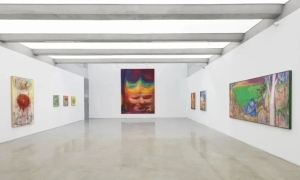展览时间:2008年11月20日-2008年12月21日
开幕式:11月20日周四下午4点-7点
展览地点:上海市徐汇区复兴西路55号菲籽画廊
2008年11月20日,由上海菲籽画廊策划的《一个人的演出——姜勇作品展》即将开幕,展览将展出目前在中国当代艺术领域相当活跃的年轻艺术家姜勇先生的近期新作。
姜勇,1965年出生于四川乐山,多年来生活和创作于有着“天府之国”美誉的成都。成都安逸、闲适的生活节奏和环境显然为他提供了充足的时间和空间来观察和审视自己的内心,让他在关注外部世界的同时也倾听内心的声音。作为艺术家的姜勇细腻、敏感而内敛,这种性情不仅在他的画中有鲜明的体现,也反映在他自己的一些片段文字之中。他写到:“生活中的很多情境和复杂多变的感情是很难表达的,生活的周围有一种气氛,一种看不见、嗅不着、触不到、只是徘徊在心中的阴影,就很难用文字语言和真实图像来表达,这时抽象的图形就显得更真实了”。这里他所谓的“抽象的图形”并不是无具象的抽象,而是一种有形象的“抽象”,这种抽象其实更多是指涉于精神上的。他画中的那一个个人物,有人的身形,却更像是特定的躯壳或符号。对于他来说,这种带有抽象性精神诉求的图形表达似乎更为快慰和准确。
中国传统哲学中讲求清净虚淡素朴的老庄思想,对姜勇的艺术创作也产生了深深的影响。姜勇曾经引用过庄子《天道》中的一句话“朴素而天之莫能与之争美”来表明自己的美学态度:“朴素这种本源性的精神力量是至高无上的,也就是说我们应该露出本来面目来”。这种影响形成姜勇个性中既随性又执拗的特点,进而形成了他今天的艺术形式和风格。在姜勇的作品中可以看到某种冲突的力量所形成的画面张力,看到画面深处所含有的某种类似于“静水深流”般的情感在缓缓流淌。
和今天的个人风格鲜明、“低温”(指画面色彩和感觉)气质的作品相比较,姜勇的早期作品,无论人物或风景,都显得那么平和而惬意,画中自然而然流淌着一种脉脉的温情,清新如三月的微风,微醺但不撩人。而近期作品则全然不同,画面上不再有纷繁的结构和层次,及令人眼花缭乱的丰富色彩,也不再有甜美的温情,然而新的作品变得更有分量且更醒目,它们让你的视觉无法忽视,更让你的心灵无法逃脱,画中那些面目不清、身份模糊的人会不断地触动你,让你深思而感慨。
有评论家曾这样解读姜勇的作品:“艺术家作品中那些一律灰绿色调的模糊的五官下,挣扎着凸现出来的尖角既是想要破茧而出的‘本我’又是因为在这日益浮躁喧嚣世界中被抹平的棱角的伤口的呻吟吧?”道出姜勇绘画中现实批判性的一面。
作为一位具有独立精神的中国当代艺术家,传统的老庄思想和西方追求个人自由的人文精神都对姜勇有着深刻的影响。从屈原的《天问》到当代悲剧诗人海子诗中所写:“我在天空深处高声询问/谁在/我/从天空站起来呼喊/又有谁在?”,人类总是反复拷问自己的内心:我们是谁?我们从哪里来?我们又往哪里去?不同于西方先辈们的激进与极端,也扬弃了老庄思想中消极与神秘论,为了将其“真实”表达于自我和世人面前,姜勇以中国人特有的机敏与智慧拿捏分寸,于云淡风轻处显露铮铮铁骨。姜勇的创作告诉我们:当人类对于自身生命的存在有着诸多困惑,也许唯一的方法就是安静下来,回到自己的内心,认真而仔细的倾听内心深处的声音。
(菲籽画廊提供)
<
Jiang Yong was born in Leshan of Sichuan in 1965. Honored as “the Land of Abundance”, Chengdu, where he is resident at, provides enough time and space for him to care about his inner feelings besides the outside world by an easy life against the comfortable social environment. He is a delicate, sensitive and quiet artist, which has been reflected clearly both in his paintings and words. He said: “It’s very difficult to express many complicated circumstances and variable feelings in the life. There’s a kind of atmosphere in the surroundings, as an imperceptible shadow remains in the heart and hard to describe through words or compare to the concrete. Instead, the abstract is much closer.” In “the abstract” he mentioned, image still plays a more important part, especially in mental world, than in others which are totally without concrete things. Those figures in his paintings have shapes of human body, but they are more like specific shells or symbols. To him, appeal for abstract spiritual expression seems more enjoyable and accurate.
Traditional Chinese philosophy of Lao Tse and Zhuang Tse who stressed on lustration also has been impressive to Jiang Yong’s art. He has quoted from <
Compared with his new sharp style in low temperature on color, his former works, no matter the figures or the landscapes, were all much gentler and flowing out tender emotions naturally as drunk slightly by the soft wind in March. However, his new series have been totally different. Giving up all the complex structures and colors, they turned to carry more weight to catch the eyes and souls without mercy. Those people in his paintings, with no faces and identities, continued to push us to think or sigh with emotion.
One critic has pointed out the realistic part of Jiang Yong’s art: “In the works, covering by those unclear faces in tune of gray, there are the struggling horns, which should be the id who wants to get out of there, or the moans of the wound of the flatted pointedness in this impetuous and noisy world.”
To be an artist in the modern China with individual spirit, the traditional thought of Lao Tse and Zhuang Tse, with the western humanism in pursuit of personal freedom also, all deeply influenced him. From <
(By Feizi Gallery)
【编辑:霍春常】





















